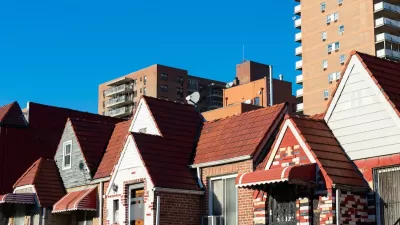The Montgomery County Council is preparing to vote on an amendment that would loosen restrictions on the controversial building type known as accessory dwelling units (ADUs).

One of the country's most famous suburban counties could add a significant amount of building capacity if the Montgomery County Council votes to approve new accessory dwelling unit (ADU) regulations in a vote on July 16.
Ally Schweitzer reports on the controversy surrounding Zoning Text Amendment 19-01, which "would slash some of the red tape that can complicate the process of adding a separate apartment to a single-family lot. It would eliminate a requirement that neighborhoods can only have one ADU every 300 or 500 feet, depending on the zone they’re in. The proposal would also remove a ban on tiny homes and other detached apartments on smaller lots, like those often found in Silver Spring and Bethesda."
Schweitzer starts the article with the story of an ADU owner that believes ADUs could make her part of country much more affordable for "senior citizens, hourly wage-earners and people just entering the workforce."
There are many others in the county, however, who oppose the loosening of ADU regulations on multiple grounds. According to Schweitzer, "opponents of the measure say adding more ADUs could crowd neighborhoods, worsen traffic congestion and exacerbate stormwater drainage issues, all while failing to create more affordable housing options. Others predict they’ll attract too many low-income residents, bringing down property values in the process."
One such resident made that last opinion clear with a letter to the editor of The Washington Post, prompting a reply on Facebook from Montgomery Countil Councilmember Nancy Navarro.
Montgomery County has been making news recently for struggling to adopt the systems and priorities of a more urban-oriented building pattern, approving a building moratorium in response to school overcrowding and also cutting back on bus service in recent weeks.
FULL STORY: A Big Fight Over Small Apartments In Montgomery County

Planetizen Federal Action Tracker
A weekly monitor of how Trump’s orders and actions are impacting planners and planning in America.

Congressman Proposes Bill to Rename DC Metro “Trump Train”
The Make Autorail Great Again Act would withhold federal funding to the system until the Washington Metropolitan Area Transit Authority (WMATA), rebrands as the Washington Metropolitan Authority for Greater Access (WMAGA).

The Simple Legislative Tool Transforming Vacant Downtowns
In California, Michigan and Georgia, an easy win is bringing dollars — and delight — back to city centers.

The States Losing Rural Delivery Rooms at an Alarming Pace
In some states, as few as 9% of rural hospitals still deliver babies. As a result, rising pre-term births, no adequate pre-term care and "harrowing" close calls are a growing reality.

The Small South Asian Republic Going all in on EVs
Thanks to one simple policy change less than five years ago, 65% of new cars in this Himalayan country are now electric.

DC Backpedals on Bike Lane Protection, Swaps Barriers for Paint
Citing aesthetic concerns, the city is removing the concrete barriers and flexposts that once separated Arizona Avenue cyclists from motor vehicles.
Urban Design for Planners 1: Software Tools
This six-course series explores essential urban design concepts using open source software and equips planners with the tools they need to participate fully in the urban design process.
Planning for Universal Design
Learn the tools for implementing Universal Design in planning regulations.
Smith Gee Studio
City of Charlotte
City of Camden Redevelopment Agency
City of Astoria
Transportation Research & Education Center (TREC) at Portland State University
US High Speed Rail Association
City of Camden Redevelopment Agency
Municipality of Princeton (NJ)





























